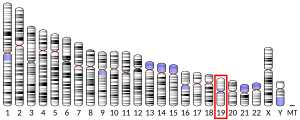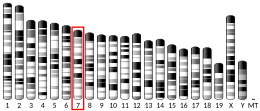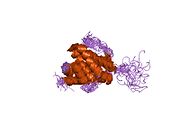Apoptosis regulator BAX
Apoptosis regulator BAX, also known as bcl-2-like protein 4, is a protein that in humans is encoded by the BAX gene.[5] BAX is a member of the Bcl-2 gene family. BCL2 family members form hetero- or homodimers and act as anti- or pro-apoptotic regulators that are involved in a wide variety of cellular activities. This protein forms a heterodimer with BCL2, and functions as an apoptotic activator. This protein is reported to interact with, and increase the opening of, the mitochondrial voltage-dependent anion channel (VDAC), which leads to the loss in membrane potential and the release of cytochrome c. The expression of this gene is regulated by the tumor suppressor P53 and has been shown to be involved in P53-mediated apoptosis.[6]
Structure
[edit]The BAX gene was the first identified pro-apoptotic member of the Bcl-2 protein family.[7] Bcl-2 family members share one or more of the four characteristic domains of homology entitled the Bcl-2 homology (BH) domains (named BH1, BH2, BH3 and BH4), and can form hetero- or homodimers.[7][8] These domains are composed of nine α-helices, with a hydrophobic α-helix core surrounded by amphipathic helices and a transmembrane C-terminal α-helix anchored to the mitochondrial outer membrane (MOM). A hydrophobic groove formed along the C-terminal of α2 to the N-terminal of α5, and some residues from α8, binds the BH3 domain of other BAX or BCL-2 proteins in its active form. In the protein's inactive form, the groove binds its transmembrane domain, transitioning it from a membrane-bound to a cytosolic protein. A smaller hydrophobic groove formed by the α1 and α6 helices is located on the opposite side of the protein from the major groove, and may serve as a BAX activation site.[9]
Orthologs of the BAX gene have been identified in most mammals for which complete genome data are available.[10]
Function
[edit]In healthy mammalian cells, the majority of BAX is found in the cytosol, but upon initiation of apoptotic signaling, Bax undergoes a conformational shift. Upon induction of apoptosis, BAX becomes organelle membrane-associated, and in particular, mitochondrial membrane associated.[11][12][13][14][15]
BAX is believed to interact with, and induce the opening of the mitochondrial voltage-dependent anion channel, VDAC.[16] Alternatively, growing evidence also suggests that activated BAX and/or Bak form an oligomeric pore, MAC in the MOM (mitochondrial outer membrane).[17][18] This results in the release of cytochrome c and other pro-apoptotic factors from the mitochondria, often referred to as mitochondrial outer membrane permeabilization, leading to activation of caspases.[19] This defines a direct role for BAX in mitochondrial outer membrane permeabilization. BAX activation is stimulated by various abiotic factors, including heat, hydrogen peroxide, low or high pH, and mitochondrial membrane remodeling. In addition, it can become activated by binding BCL-2, as well as non-BCL-2 proteins such as p53 and Bif-1. Conversely, BAX can become inactivated by interacting with VDAC2, Pin1, and IBRDC2.[9]
Clinical significance
[edit]The expression of BAX is upregulated by the tumor suppressor protein p53, and BAX has been shown to be involved in p53-mediated apoptosis. The p53 protein is a transcription factor that, when activated as part of the cell's response to stress, regulates many downstream target genes, including BAX. Wild-type p53 has been demonstrated to upregulate the transcription of a chimeric reporter plasmid utilizing the consensus promoter sequence of BAX approximately 50-fold over mutant p53. Thus it is likely that p53 promotes BAX's apoptotic faculties in vivo as a primary transcription factor. However, p53 also has a transcription-independent role in apoptosis. In particular, p53 interacts with BAX, promoting its activation as well as its insertion into the mitochondrial membrane.[20][21][22]
Drugs that activate BAX, such as ABT-737, a BH3 mimetic, hold promise as anticancer treatments by inducing apoptosis in cancer cells.[9] For instance, binding of HA-BAD to BCL-xL and concomitant disruption of BAX:BCL-xL interaction was found to partly reverse paclitaxel resistance in human ovarian cancer cells.[23] Meanwhile, excessive apoptosis in such conditions as ischemia reperfusion injury and amyotrophic lateral sclerosis may benefit from drug inhibitors of BAX.[9]
Interactions
[edit]
Bcl-2-associated X protein has been shown to interact with:
See also
[edit]References
[edit]- ^ a b c GRCh38: Ensembl release 89: ENSG00000087088 – Ensembl, May 2017
- ^ a b c GRCm38: Ensembl release 89: ENSMUSG00000003873 – Ensembl, May 2017
- ^ "Human PubMed Reference:". National Center for Biotechnology Information, U.S. National Library of Medicine.
- ^ "Mouse PubMed Reference:". National Center for Biotechnology Information, U.S. National Library of Medicine.
- ^ "UniProt". www.uniprot.org. Retrieved 30 April 2023.
- ^ "Entrez Gene: BCL2-associated X protein".
- ^ a b c Oltvai ZN, Milliman CL, Korsmeyer SJ (August 1993). "Bcl-2 heterodimerizes in vivo with a conserved homolog, Bax, that accelerates programmed cell death". Cell. 74 (4): 609–619. doi:10.1016/0092-8674(93)90509-O. PMID 8358790. S2CID 31151334.
- ^ a b c d Sedlak TW, Oltvai ZN, Yang E, Wang K, Boise LH, Thompson CB, et al. (August 1995). "Multiple Bcl-2 family members demonstrate selective dimerizations with Bax". Proceedings of the National Academy of Sciences of the United States of America. 92 (17): 7834–7838. Bibcode:1995PNAS...92.7834S. doi:10.1073/pnas.92.17.7834. PMC 41240. PMID 7644501.
- ^ a b c d e f g h Westphal D, Kluck RM, Dewson G (February 2014). "Building blocks of the apoptotic pore: how Bax and Bak are activated and oligomerize during apoptosis". Cell Death and Differentiation. 21 (2): 196–205. doi:10.1038/cdd.2013.139. PMC 3890949. PMID 24162660.
- ^ "OrthoMaM phylogenetic marker: BAX coding sequence". Archived from the original on 24 September 2015. Retrieved 20 December 2009.
- ^ Gross A, Jockel J, Wei MC, Korsmeyer SJ (July 1998). "Enforced dimerization of BAX results in its translocation, mitochondrial dysfunction and apoptosis". The EMBO Journal. 17 (14): 3878–3885. doi:10.1093/emboj/17.14.3878. PMC 1170723. PMID 9670005.
- ^ Hsu YT, Wolter KG, Youle RJ (April 1997). "Cytosol-to-membrane redistribution of Bax and Bcl-X(L) during apoptosis". Proceedings of the National Academy of Sciences of the United States of America. 94 (8): 3668–3672. Bibcode:1997PNAS...94.3668H. doi:10.1073/pnas.94.8.3668. PMC 20498. PMID 9108035.
- ^ Nechushtan A, Smith CL, Hsu YT, Youle RJ (May 1999). "Conformation of the Bax C-terminus regulates subcellular location and cell death". The EMBO Journal. 18 (9): 2330–2341. doi:10.1093/emboj/18.9.2330. PMC 1171316. PMID 10228148.
- ^ a b Pierrat B, Simonen M, Cueto M, Mestan J, Ferrigno P, Heim J (January 2001). "SH3GLB, a new endophilin-related protein family featuring an SH3 domain". Genomics. 71 (2): 222–234. doi:10.1006/geno.2000.6378. PMID 11161816.
- ^ Wolter KG, Hsu YT, Smith CL, Nechushtan A, Xi XG, Youle RJ (December 1997). "Movement of Bax from the cytosol to mitochondria during apoptosis". The Journal of Cell Biology. 139 (5): 1281–1292. doi:10.1083/jcb.139.5.1281. PMC 2140220. PMID 9382873.
- ^ a b Shi Y, Chen J, Weng C, Chen R, Zheng Y, Chen Q, et al. (June 2003). "Identification of the protein-protein contact site and interaction mode of human VDAC1 with Bcl-2 family proteins". Biochemical and Biophysical Research Communications. 305 (4): 989–996. doi:10.1016/S0006-291X(03)00871-4. PMID 12767928.
- ^ Buytaert E, Callewaert G, Vandenheede JR, Agostinis P (2006). "Deficiency in apoptotic effectors Bax and Bak reveals an autophagic cell death pathway initiated by photodamage to the endoplasmic reticulum". Autophagy. 2 (3): 238–240. doi:10.4161/auto.2730. PMID 16874066.
- ^ McArthur K, Whitehead LW, Heddleston JM, Li L, Padman BS, Oorschot V, et al. (February 2018). "BAK/BAX macropores facilitate mitochondrial herniation and mtDNA efflux during apoptosis". Science. 359 (6378): eaao6047. doi:10.1126/science.aao6047. PMID 29472455.
- ^ a b Weng C, Li Y, Xu D, Shi Y, Tang H (March 2005). "Specific cleavage of Mcl-1 by caspase-3 in tumor necrosis factor-related apoptosis-inducing ligand (TRAIL)-induced apoptosis in Jurkat leukemia T cells". The Journal of Biological Chemistry. 280 (11): 10491–10500. doi:10.1074/jbc.M412819200. PMID 15637055.
- ^ Miyashita T, Krajewski S, Krajewska M, Wang HG, Lin HK, Liebermann DA, et al. (June 1994). "Tumor suppressor p53 is a regulator of bcl-2 and bax gene expression in vitro and in vivo". Oncogene. 9 (6): 1799–1805. PMID 8183579.
- ^ Selvakumaran M, Lin HK, Miyashita T, Wang HG, Krajewski S, Reed JC, et al. (June 1994). "Immediate early up-regulation of bax expression by p53 but not TGF beta 1: a paradigm for distinct apoptotic pathways". Oncogene. 9 (6): 1791–1798. PMID 8183578.
- ^ Miyashita T, Reed JC (January 1995). "Tumor suppressor p53 is a direct transcriptional activator of the human bax gene". Cell. 80 (2): 293–299. doi:10.1016/0092-8674(95)90412-3. PMID 7834749. S2CID 14495370.
- ^ a b Strobel T, Tai YT, Korsmeyer S, Cannistra SA (November 1998). "BAD partly reverses paclitaxel resistance in human ovarian cancer cells". Oncogene. 17 (19): 2419–2427. doi:10.1038/sj.onc.1202180. PMID 9824152. S2CID 44240363.
- ^ Hoetelmans RW (June 2004). "Nuclear partners of Bcl-2: Bax and PML". DNA and Cell Biology. 23 (6): 351–354. doi:10.1089/104454904323145236. PMID 15231068.
- ^ Lin B, Kolluri SK, Lin F, Liu W, Han YH, Cao X, et al. (February 2004). "Conversion of Bcl-2 from protector to killer by interaction with nuclear orphan receptor Nur77/TR3". Cell. 116 (4): 527–540. doi:10.1016/S0092-8674(04)00162-X. PMID 14980220. S2CID 17808479.
- ^ Komatsu K, Miyashita T, Hang H, Hopkins KM, Zheng W, Cuddeback S, et al. (January 2000). "Human homologue of S. pombe Rad9 interacts with BCL-2/BCL-xL and promotes apoptosis". Nature Cell Biology. 2 (1): 1–6. doi:10.1038/71316. PMID 10620799. S2CID 52847351.
- ^ Zhang H, Nimmer P, Rosenberg SH, Ng SC, Joseph M (August 2002). "Development of a high-throughput fluorescence polarization assay for Bcl-x(L)". Analytical Biochemistry. 307 (1): 70–75. doi:10.1016/S0003-2697(02)00028-3. PMID 12137781.
- ^ Gillissen B, Essmann F, Graupner V, Stärck L, Radetzki S, Dörken B, et al. (July 2003). "Induction of cell death by the BH3-only Bcl-2 homolog Nbk/Bik is mediated by an entirely Bax-dependent mitochondrial pathway". The EMBO Journal. 22 (14): 3580–3590. doi:10.1093/emboj/cdg343. PMC 165613. PMID 12853473.
- ^ Zhang H, Cowan-Jacob SW, Simonen M, Greenhalf W, Heim J, Meyhack B (April 2000). "Structural basis of BFL-1 for its interaction with BAX and its anti-apoptotic action in mammalian and yeast cells". The Journal of Biological Chemistry. 275 (15): 11092–11099. doi:10.1074/jbc.275.15.11092. PMID 10753914.
- ^ Cuddeback SM, Yamaguchi H, Komatsu K, Miyashita T, Yamada M, Wu C, et al. (June 2001). "Molecular cloning and characterization of Bif-1. A novel Src homology 3 domain-containing protein that associates with Bax". The Journal of Biological Chemistry. 276 (23): 20559–20565. doi:10.1074/jbc.M101527200. PMID 11259440.
- ^ Marzo I, Brenner C, Zamzami N, Jürgensmeier JM, Susin SA, Vieira HL, et al. (September 1998). "Bax and adenine nucleotide translocator cooperate in the mitochondrial control of apoptosis". Science. 281 (5385): 2027–2031. Bibcode:1998Sci...281.2027M. doi:10.1126/science.281.5385.2027. PMID 9748162.
- ^ Susini L, Besse S, Duflaut D, Lespagnol A, Beekman C, Fiucci G, et al. (August 2008). "TCTP protects from apoptotic cell death by antagonizing bax function". Cell Death and Differentiation. 15 (8): 1211–1220. doi:10.1038/cdd.2008.18. PMID 18274553.
- ^ Nomura M, Shimizu S, Sugiyama T, Narita M, Ito T, Matsuda H, et al. (January 2003). "14-3-3 Interacts directly with and negatively regulates pro-apoptotic Bax". The Journal of Biological Chemistry. 278 (3): 2058–2065. doi:10.1074/jbc.M207880200. PMID 12426317.
- ^ Hoppins S, Edlich F, Cleland MM, Banerjee S, McCaffery JM, Youle RJ, et al. (January 2011). "The soluble form of Bax regulates mitochondrial fusion via MFN2 homotypic complexes". Molecular Cell. 41 (2): 150–160. doi:10.1016/j.molcel.2010.11.030. PMC 3072068. PMID 21255726.
- ^ a b Mignard V, Lalier L, Paris F, Vallette FM (May 2014). "Bioactive lipids and the control of Bax pro-apoptotic activity". Cell Death & Disease. 5 (5): e1266. doi:10.1038/cddis.2014.226. PMC 4047880. PMID 24874738.
External links
[edit]- Human BAX genome location and BAX gene details page in the UCSC Genome Browser.
- Overview of all the structural information available in the PDB for UniProt: Q07812 (Human Apoptosis regulator BAX) at the PDBe-KB.
- Overview of all the structural information available in the PDB for UniProt: Q07813 (Mouse Apoptosis regulator BAX) at the PDBe-KB.







